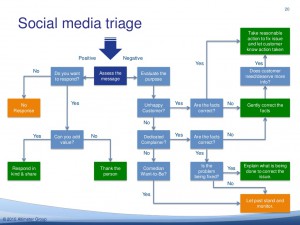The growing importance of social media in business is undeniable. Each of the online social platforms offers something unique and holds a huge potential for marketing and advertising to highly targeted groups of potential customers. Venturing into social media, however, doesn’t mean setting up profiles in every medium available. You have to find out where your clients are, in order to focus your marketing efforts. Moreover, you have to be ready to tackle a variety of situations involving your clients. To make your life easier, I’ve covered some of the best social media customer service practices, including examples, in the post below. Stay with me to step your social game up!
There’s definitely a degree of segmentation among social media users. Facebook has become a business staple, Twitter is frequented by the more tech-savvy population, teenagers use Snapchat, while foodies and fashion aficionados link up on Instagram.
For you, as a business, mere presence is not enough. You need to be shining, stellar. Despite what some people think, social media aren’t about grabbing as many fans as possible. Delivering excellent experience is achieved through getting them engaged, telling a story, creating a character, all of which should lead to conversion. Also, the necessity to provide social media customer service becomes even more apparent when you consider that:
“According to Nielsen’s 2012 Social Media Report, nearly half of U.S. consumers use social media to ask questions, report satisfaction, or to complain – and a third of social media users prefer ‘social care’ to the phone.”
An increasing number of people use the online social sphere to communicate with brands. The impression they get out of social media customer service can make or break a deal and influence their future choices. Thus, proper handling of all types of messages, from praise to suggestions and questions, to complaints, is crucial from a business standpoint.
Consumers have become empowered in many ways. They have uninterrupted access to a see of information and many are taking advantage of it. Ignoring the social chatter is something you can’t afford to do, as it happens whether you like it or not. The best thing you can do is be where your customers are to deliver great social media customer service and build relations.
Reply promptly
Let me start with what I believe to be the most important aspect of social media customer service, that is replying promptly. Not within 24h, not when you feel like it (although obviously, you don’t have to reply to every single comment or mention) but as soon as possible, which in practice means about 15 minutes.
Despite the fact that the medium is different, the etiquette involved in social media customer service isn’t that different from, say, telephone service. Would you put your client on hold until the next day? Didn’t think so. If you’re unable to have SM managers available at most times, and you expect or actually regularly experience significant activity among your fans, the least you can do is provide clear information on the hours your social media customer service is available at.
“A study by Lithium Technologies found that 53% of customers who ask a brand a question on Twitter expect a response within 1 hour regardless of when they tweeted, with that percentage rising to 72% if it’s a complaint.”
Needless to say, the reality of social media customer service often doesn’t meet these expectations. Recently, I saw a post by a local branch of a global brand I’m sure all of the readers are familiar with on my Facebook wall, regarding their new product. The message wasn’t clear enough so I asked them a simple question. The response came TEN DAYS LATER (sic!).
Welp, of course it wasn’t that serious and not a reason for me to get angry, however, I can’t say it was great social media customer service either. Imagine a store clerk coming back ten days after you asked him about a pair of shoes in your size just to find you’ve already bought from another brand.
No one likes waiting, on anything, especially on the Internet. There are people too, who find such behavior disrespectful and make it their objective to (somewhat rightfully) badmouth you on the web and offline. It won’t matter that they’re blowing a minor issue out of proportion, the damage is done.
My suggestion is to have staff regularly monitoring your social media channels. You never know when a product-related question or a complaint may pop up, especially if you’re a bigger company with large following. If you receive a lot of business inquires, consider creating response templates that can be copy-pasted into comments. Also, promote self-service by creating a clever hashtag like #AskCompanyName or #UseProductName and prompting customers to use it to answer each other’s questions. You can use it too to monitor what is being said about your brand.
BONUS. Take a look at the chart below created by Altimeter Group for a quick reference regarding the course of action you can take in response to comments or tweets concerning your company (click to enlarge).
Never react aggressively to criticism
No matter how hard you try and how high your social media customer service quality level is, you’ll never please everybody. You’ll experience negative comments and criticism on social media in any case.
The trick is to not react hastily or take up defensive position. I know it’s not always easy with all kinds of hecklers online, but reflecting their aggressive tone is not the way to go about social media customer service. They may have a point anyway, so stirring up negative publicity may result in a snowball effect.
Nothing really disappears on the Internet. If someone has posted a negative comment to your Facebook wall, chances are that a lot of people have seen it, unless you only have a couple dozens of fans, in which case you should probably pay even more attention to what they’re saying.
By trying to retaliate in an aggressive manner, you risk ending up on one of many fail-type websites aggregating, among other things, funny, weird or plain bad instances of online behavior. Forever, for anyone to see.
Basically, you’re arguing in public which is a battle you can’t win in the long run. When it comes to social media customer service, discussion is the way to go (look at the graph above for tips on how to act). Slow down, look at the big picture and don’t let other people develop a negative opinion about your brand by seeing you threaten someone.
Aim to settle the issue directly with the complainer
Look at it this way – if an unhappy client has decided to tell you how he feels about a certain product/service he bought/received via your Facebook wall/@ing you on Twitter, it’s not that bad yet. It means he’s probably willing to work something out and stay with your brand. Otherwise, he might have been so angry as to not bother with that at all and proceed straight to disseminating negative opinion among their friends and creating damage to your image in the real world.
For instance, I have a couple of friends who are pretty well-known in certain circles (judging by the number of likes they get under their Facebook posts, their opinion seems to matter to a lot of people) and I’ve seen them complain about and post poor reviews (you know, on Facebook you can award 1-5 stars) of some restaurants. I haven’t done any research regarding the impact of those negative comments on the grub-spots’ business, but it makes you wonder how many people opted for another diner while they were roaming downtown?
This was probably ‘just’ a matter of not gaining new clients, and not enduring any hard, long-lasting damage but that’s one of numerous examples. What the social media managers should’ve done in an attempt to deliver great social media customer service is reach out to them after seeing the poor review in order to find exactly what went wrong and try to fix it. I’m pretty sure it would go a long way and they could expect some extra praise afterwards that would reach, again, a considerable number of people, 4,000+ to be exact.
Yes, it’s an extra investment of time and most likely money but you never know who’s complaining (well, sometimes you do but then you take action, I guess) and how much damage they can do to your business. Fixing the hole while it’s small seems like a reasonable solution.
Social media customer service in the form of reaching out will actually surprise the complainer and should soften him a bit and prevent him from disseminating the insults further. Send a Twitter DM (direct message, you can contact anyone who hasn’t blocked you, anytime) or mention them directly on Facebook, asking to send you a private message (a page cannot send messages to its fans).
The point is to get this angry shouter out of the public forum. If you reach common ground, you can discreetly ask the customer not as much to withdraw or delete the statement (this seems a bit shady) but to speak publicly about the resolution (“we’d appreciate if you could…”).
If possible, address complaints in public (if there’s no need to obtain some personal information, etc.) to show you can be trusted and care. This also may help other customers who are reading the exchange with their similar problems. Pushing customers through the funnel is something they obviously don’t like and if they expect social media customer service, then adjust to it.
Have the right people communicate the right way
What I mean by that, essentially, is that you should have staff dedicated to providing broadly understood social media customer service, and not have people who only do it part-time, and whose main tasks are different.
Now, I understand this may not always be possible. There may be a situation where the service provide has to play the role of social media manager too. Say, a small beauty parlor owner, who’s also a hairdresser, manages her own company accounts.
That should be fine, as long as she implements all the social media customer service practices discussed here and polishes up on soft skills a little bit. These days, people expect the same, high level of CS on Facebook, as they’d expect through more traditional channels like email or phone. Thus, the person in charge of the accounts needs proper training in new technologies and techniques of dealing with clients alike.
And speaking of soft skills, the aspect of customer service that always draws my attention is the language used. And let me tell you, I’m not a big fan of it being too subservient, as it seems to me to be insincere and reminds me of processed, deep-frozen food.
Being polite is how civilized people interact in any situation, not only in social media customer service, and is a standard to aspire to. My suggestion is to simply not try and insert ‘kind words’ in each and every sentence to create an overkill. An occasional emoji to convey sympathy or good intent won’t hurt either. Strive to create a balance between being formally polite and humanely natural.
Build relations and loyalty through social media customer service
This is one of the main business purposes of being present in social media and there is a number of ways to do that. The good thing about online social platforms is that they work for both ends of the spectrum, that is your clients and yourself.
Businesses can use Facebook or Twitter to build their image and develop a strong voice in the discussion that’s taking place anyway. Social media customer service creates an opportunity to turn disgruntled clients into loyal fans by resolving their issues in a timely fashion. If they’re treated right, you can count on recommendations and word-of-mouth marketing, which go a long way. According to research by J.D. Power:
“Forty-two percent of social media customers will tell others about a positive experience, while just 15% of the general population will tell others. Plus, 53% of social media users talk about bad experiences, while just 24% of the general population spread the negative word”
By delivering excellent social media customer service, you develop a connection with the clients, who as research shows, are willing to spend 21% more as a result of great experience.
As a business, you can’t just wait for opinions to flow in. You have to proactively shape them by reaching out to customers. Browse your Twitter mentions and related hashtags to become a part of the discussion. Communicate information important to your audience, give tips, deliver something your fans will appreciate and find useful.
Act to prevent online complaints
The online social sphere, that your brand may be a part of, goes way beyond your company profiles. It extends to places you have little to no control over, from various review sites, discussion boards, to personal blogs.
By communicating clearly that you’re approachable and ready to listen, you can prevent people from looking for ways to channel their frustration or disappointment. If they’ll know they have a contact form they can use, or talk to you on Facebook and actually be heard, they’ll utilize these options.
You can expand your social media customer service practices even further by providing additional means of instant communication like live chat installed on your website. This tool allows you to deliver immediate assistance to clients in need or it can act as an alternative to FAQ section. Live chat is affordable, doesn’t require you to have coding knowledge to implement it and it finds application in a variety of industries.
Conclusions
Ok, time to sum up this discussion of the best social media customer service practices. It’s safe to say that the new generation of customers is a lot more efficient at and willing to use various methods of online communication, regardless of the industry.
They’re also increasingly expectant in terms of obtaining the kind of reaction to their issues they deserve, which, when combined with extreme competition in many areas, leaves you no choice but to deliver excellent customer service on multiple levels, including social media channels.
Social media as a customer service channel is a reality and turning your back to it doesn’t really solve any problems. In fact, the number of social network users is growing and it is expected to continue to do so, so keeping a high standard of social media customer service should be a priority to any business.




